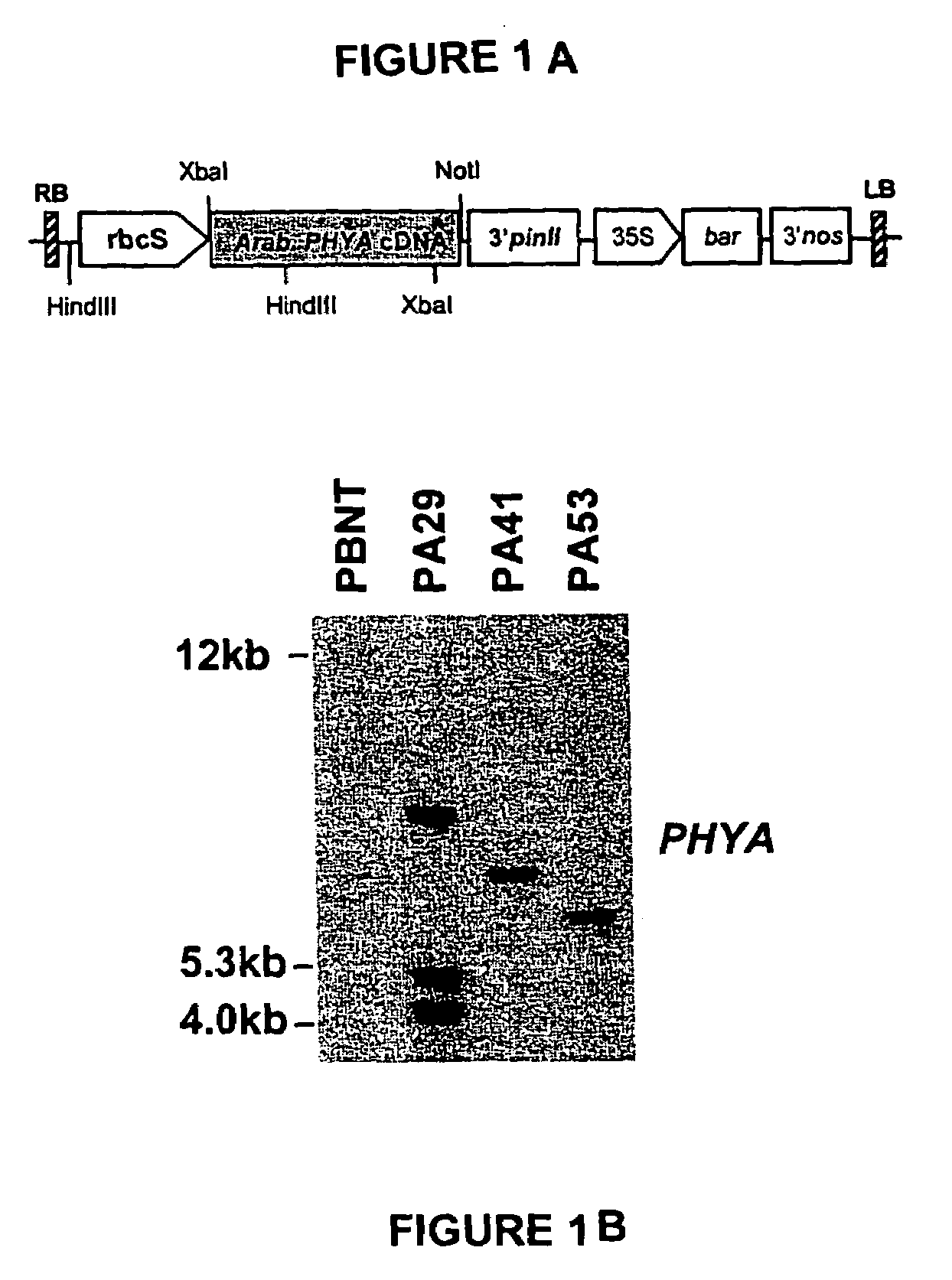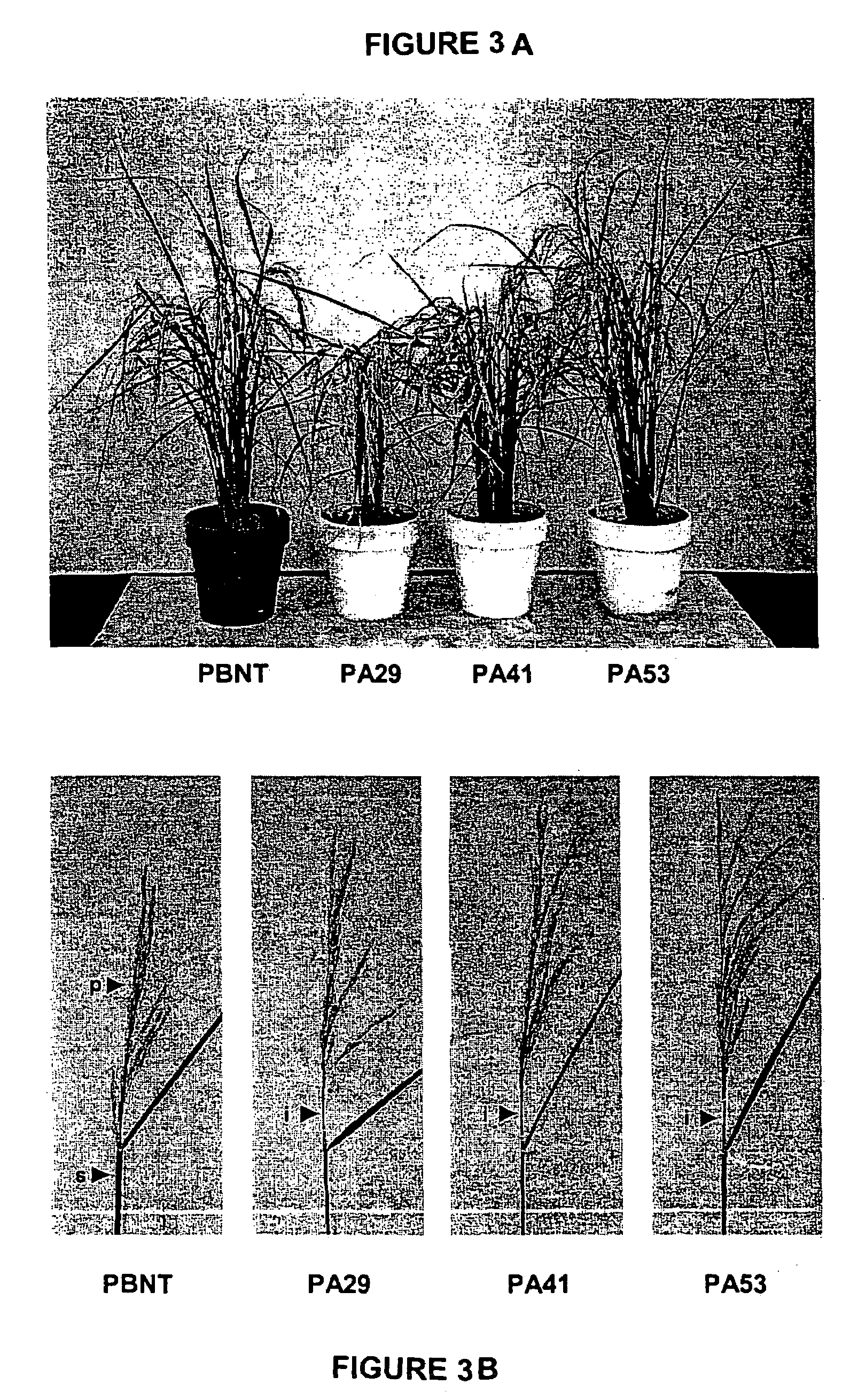Transgenic expression of a phytochrome a gene
a technology of transgenic expression and gene, applied in the field of transgenic expression of a phytochrome a gene, can solve the problems of inability to restore the response to low r:fr ratio, at odds with the agronomic performance of cultivated plants, and difficult to ascertain the precise role of phya and phyb in regulating mature plant development, etc., to achieve the effect of enhancing grain yield, reducing or eliminating the shade-avoidance syndrome of plants, and enhancing grain yield
- Summary
- Abstract
- Description
- Claims
- Application Information
AI Technical Summary
Benefits of technology
Problems solved by technology
Method used
Image
Examples
example 1
Plasmid Construction
[0057]The binary plasmid, pSBR 3.7 containing a full-length Arabidopsis PHYA cDNA (Sharrock et al., “Novel Phytochrome Sequences in Arabidopsis thaliana: Structure, Evolution, and Differential Expression of a Plant Regulatory Photoreceptor Family,”Genes Dev. 3:1745-1757 (1989), which is hereby incorporated by reference in its entirety) was constructed in the pSB11 vector (Komari et al., “Vectors Carrying Two Separate T-DNAs for Co-transformation of Higher Plants Mediated by Agrobacterium tumefaciens and Segregation of Transformants Free From Selection Markers,”Plant J. 10-165-174 (1996), which is hereby incorporated by reference in its entirety) using standard cloning and plasmid manipulations procedures. The components of the plasmid within the T-DNA region, and the selected restriction enzyme sites are shown in FIG. 1A. The expression cassette in pSBR 3.7 consists of the 1.3 kb rice RbcS promoter (Kyozuka et al., “Light-regulated and Cell-specific Expression of...
example 2
Generation of Transgenic Rice Plants
[0058]Agrobacterium-mediated transformation of indica rice variety Pusa Basmati-1 (“PBNT”) was carried out as described earlier. Garg et al., “Trehalose Accumulation in Rice Plants Confers High Tolerance Levels to Different Abiotic Stresses,”Proc. Natl. Acad. Sci. USA 99:15898-15903 (2002), which is hereby incorporated by reference in its entirety. Briefly, scutella-derived embryogenic calli were used for co-cultivation with Agrobacterium tumefaciens strain LBA4404 harboring pSBR 3.7. Three days after co-cultivation, calli were selected on a callusing medium containing 6 mg / liter bialaphos and 250 mg / liter cefotaxime. Further, micro-calli that had proliferated on fresh selection medium (two selection cycles) were transferred to regeneration medium containing 4 mg / liter bialaphos. The regenerated plantlets were acclimatized hydroponically in Yoshida nutrient solution, transferred to pots and tested for Basta-herbicide resistance. Roy et al., “Argin...
example 3
DNA-blot Hybridization Analysis
[0059]Leaves from a non-transgenic control (“PBNT”) plant, and forty-three independent putative T0 transformants that were transformed with the plasmid pSBR 3.7, were ground in liquid nitrogen using a mortar and pestle. Rice genomic DNA was isolated by the guanidine-detergent lysis method using DNAzolES (Molecular Research Center, Inc., Cincinnati, Ohio, USA) following the manufacturer's instructions. Five micrograms of the genomic DNA was digested overnight with the HindIII restriction enzyme, fractionated through 0.8% agarose gel, alkali transferred onto Hybond N+nylon membrane (Amersham Pharmacia, Piscataway, N.J., USA) and hybridized with α-32P-labeled, 2.24 kb Arabidopsis PHYA coding region (HindIII and XbaI fragment) as the probe. DNA probe preparation, hybridization, and washing of the membrane were performed as described. Roy et al., “Arginine Decarboxylase Transgene Expression and Analysis of Environmental Stress Tolerance in Transgenic Rice,”...
PUM
| Property | Measurement | Unit |
|---|---|---|
| Light | aaaaa | aaaaa |
Abstract
Description
Claims
Application Information
 Login to View More
Login to View More - R&D
- Intellectual Property
- Life Sciences
- Materials
- Tech Scout
- Unparalleled Data Quality
- Higher Quality Content
- 60% Fewer Hallucinations
Browse by: Latest US Patents, China's latest patents, Technical Efficacy Thesaurus, Application Domain, Technology Topic, Popular Technical Reports.
© 2025 PatSnap. All rights reserved.Legal|Privacy policy|Modern Slavery Act Transparency Statement|Sitemap|About US| Contact US: help@patsnap.com



